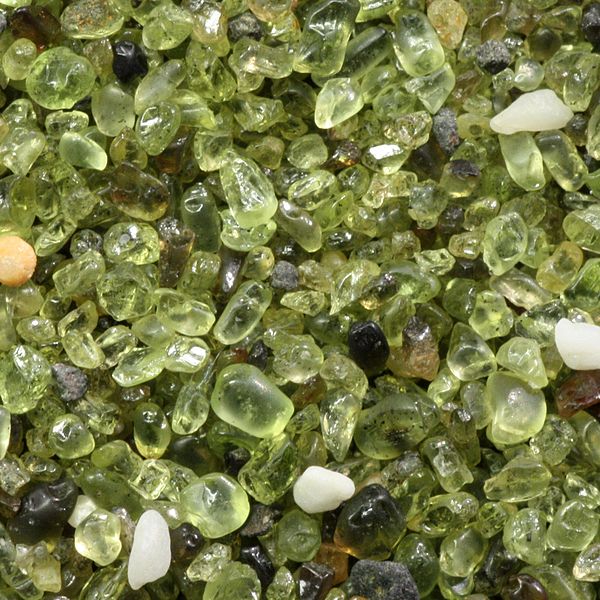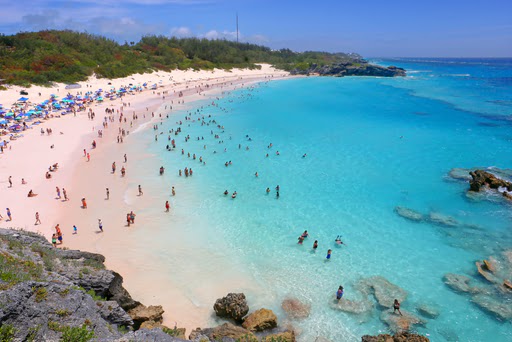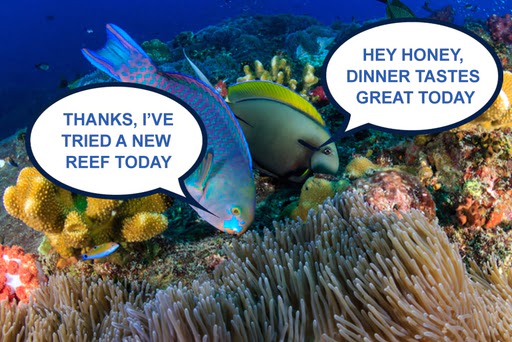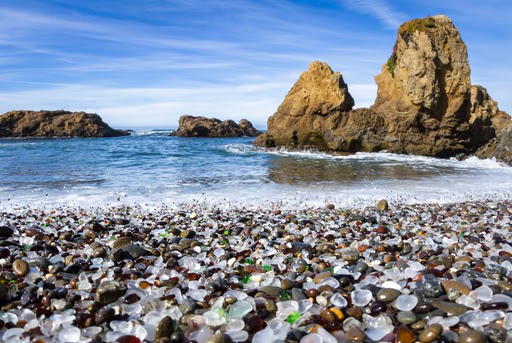Sand is composed of rocks that have been eroded by rivers, the remains of invertebrates, and calcium carbonate from parrotfish feces!
People often overlook sand. While we may use it to build sandcastles at the beach or as a picturesque backdrop for our summer Instagram posts, we rarely stop to think about its composition. From a distance, sand appears as a golden stretch of land meeting the sea.
However, if we were to examine sand under a microscope, an entire new world would be revealed.
Indeed, the question of “what is sand made of?” is quite captivating… the answers involve time travel, fish excrement, and pink skeletons!
- Sand Is Formed Through Rock Erosion
- Sand is Formed from the Remains of Marine Creatures
- The Pink Beaches of Bermuda
- Parrotfish Excrement Forms Sand
- Organic Matter Contributes to Sand Composition
- Glass Beach, California – A Beach Formed from Waste
- Glass Beach in California
- Photo Credit : Wollertz/Shutterstock
Sand Is Formed Through Rock Erosion
A significant portion of beach and desert sand is the result of rock erosion.
As rivers flow downstream from their source, their forceful movement erodes rocks into tiny mineral grains, carrying these fragments with them. Along the river’s journey, the pebbles continue to break down, ultimately transforming into sand by the time the river reaches its destination.
When the river meets the ocean, it deposits some of the sand onto the land. The constant motion of the waves redistributes the sand, creating the picturesque coastlines we enjoy during summer vacations. Smaller sediments are further carried into the sea.
The composition of sand may vary depending on the types of rocks eroded by the river. Brown and golden sand typically consists of feldspar, a brown to tan-colored mineral, and quartz, which contains iron oxide, giving it a golden-brown tint. Darker black sand is formed from basalt, a volcanic rock. This type of sand is commonly found in the ocean crust or in areas with significant volcanic activity, such as the Hawaiian islands.
The image below depicts sand from Hawaii magnified under a microscope. The green-tinted pebbles are Olivine, a mineral derived from volcanic basaltic rocks. The black specks in the image represent basalt. The presence of numerous active volcanoes in Hawaii explains the abundance of this type of sand.
 This is sand from Hawaii under a microscope. The green-tinted pebbles are Olivine, a mineral that comes from volcanic basaltic rocks. The black flecks in the picture are basalt. Hawaii has many active volcanoes, which explains why these types of sand are found there. (Photo Credit: Siim Sepp/Wikimedia Commons)
This is sand from Hawaii under a microscope. The green-tinted pebbles are Olivine, a mineral that comes from volcanic basaltic rocks. The black flecks in the picture are basalt. Hawaii has many active volcanoes, which explains why these types of sand are found there. (Photo Credit: Siim Sepp/Wikimedia Commons)
The size of sand grains is determined by their level of weathering. Finer sand grains indicate longer exposure to water erosion.
By studying the minerals present in sand, geologists can gain insights into the formation of landmasses. For example, the basalt-rich sand found in Hawaii allows scientists to study the origins of the islands and determine how and when they formed.
Interestingly, desert sand also originates from beach sand. When waves hit the coast at an angle, they carry sand along, gradually elongating the coastlines. However, wind can sometimes blow the sand inland, forming sand dunes.
Sand is Formed from the Remains of Marine Creatures
Sand is not only created by natural forces, but it is also formed by the skeletons of various marine organisms like clams, coral, and other shell-bearing creatures that inhabit the sea. These shells, which we often find and collect at the beach, are carried by waves and gradually break down into finer grains of sand.
(Original text: Life forms also contribute to sand. In fact, sand is made up of the skeletons of many invertebrates, such as clams, coral and other creatures with shells that live in the sea. These are the same shells we see, love and collect when we go to the beach. The waves carry them to the shore, where they settle. They too slowly erode to become finer grains of sand.)
The Pink Beaches of Bermuda
Aside from shells, there are other organisms that play a role in the production of sand worldwide. For instance, the pink beaches in Bermuda owe their unique color to foraminifera. These single-celled protists with shells, commonly known as foraminifera, reside in the ocean. Certain species of red-colored foraminifera are responsible for giving Bermuda’s sands a pink hue.

These red foraminifera thrive near the coral reefs of Bermuda. Upon their death, their red shells are carried to the shore where they mix with the white sand, resulting in the picturesque pink sands that Bermuda is famous for.
(Original text: There are a few other organisms that contribute to sand around the world. Foraminifera, for example, are responsible for the pink beaches in Bermuda. Foraminifera (as they are colloquially called) are single-celled shelled protists that live in the ocean. A certain red-colored species of foraminifera gives Bermuda’s sands a pink hue.)
Parrotfish Excrement Forms Sand
Incredible as it may sound, sand can also be derived from the excrement of parrotfish. Parrotfish, known for their vibrant colors, spend the majority of their time consuming coral, specifically the algae that grows on it. Using their beak-like mouth, they scrape and devour chunks of coral as their daily sustenance.

As the coral passes through the parrotfish’s digestive system, the algae is digested, while the coral reef’s rocky calcium carbonate remains intact. Since parrotfish are unable to digest calcium carbonate, they excrete it as fine powdered sand.
A single large parrotfish can produce up to 450 kg (1,000 pounds) of calcium carbonate sand in a year. This abundant excrement contributes to the creation of tropical beaches in Hawaii, the Maldives, and the Caribbean, which are renowned for their stunning white sands.
(Original text: Sand is also made from poop. Yes, you heard that right… and more specifically, the poop of parrotfish. Parrotfish are like the cows of the seas. These colorful tropical fish spend almost 90% of their time eating coral, or rather, the algae that grows on the coral. They use their hard beak-like mouth to scrape out and eat chunks of coral for their daily meals. As the coral passes through the parrotfish’s gut, the algae within the coral is digested, while the rocky calcium carbonate that composes the coral reef remains. Since the parrotfish cannot digest the calcium carbonate, it excretes it out as fine powdered sand. The parrotfish poops out so much of this that it goes on to form entire beaches! One large parrotfish can produce as much as 450 kg (1,000 pounds) of calcium carbonate sand in a single year. The mesmerizing white tropical beaches of Hawaii, the Maldives and the Caribbean are primarily formed from parrotfish poop.)
Organic Matter Contributes to Sand Composition
Beach sand is not just a collection of minerals; it also contains a diverse micro-ecosystem. Although invisible to the naked eye, sand is teeming with algae, which play a vital role in the health of large and interconnected ecosystems.
Algae, commonly found in sand, are capable of photosynthesis and produce various molecules, including oxygen. They are an integral part of a healthy ecosystem, upon which many marine and coastal organisms depend, forming an essential component of the food web.
(Original text: Beach sand is also replete with living life. Though you can’t see it, sand contains a rich micro-ecosystem that is important for the health of large ecosystems and other interdependent ecosystems. Algae are very common inhabitants of sand. These algae can photosynthesize and produce a variety of molecules (not to forget oxygen from photosynthesis) that make them a part of a healthy ecosystem. Many marine or coast-dwelling organisms depend on this algae, making them an important part of the food web.)
Glass Beach, California – A Beach Formed from Waste
Unbelievably, human waste can also contribute to the creation of beaches. In 1949, California began using what is now known as Glass Beach as a dumping ground for various types of garbage, including vehicles, food waste, pots, and glass. After nearly two decades, authorities realized that this was not an ideal solution and closed the area to dumping.
Over time, several clean-up initiatives were undertaken to restore the beach. Toxic waste was removed, and biodegradable materials were degraded. The erosive action of the water rounded off and weathered the tiny pieces of glass and clay from the pots, giving the beach a multicolored effect.
(Original text: Human waste can also form beaches. In 1949, the State of California began using the area that is now Glass Beach as a dumping ground for all sorts of garbage, from vehicles and food to pots and glass. Eventually, after almost 20 years, the authorities realized that dumping garbage there wasn’t the best plan and shut the area down. Gradually, several clean-up initiatives began work on the beach. Toxic waste was removed and biodegradable material was degraded. The water did its job of eroding the tiny pieces of glass and clay from pots by rounding them off and giving the beach a multicolored effect.)

Glass Beach in California
Photo Credit : Wollertz/Shutterstock
Sand serves more than just the purpose of building sand castles or sunbathing. It also offers us new perspectives on the world and our position in it!
